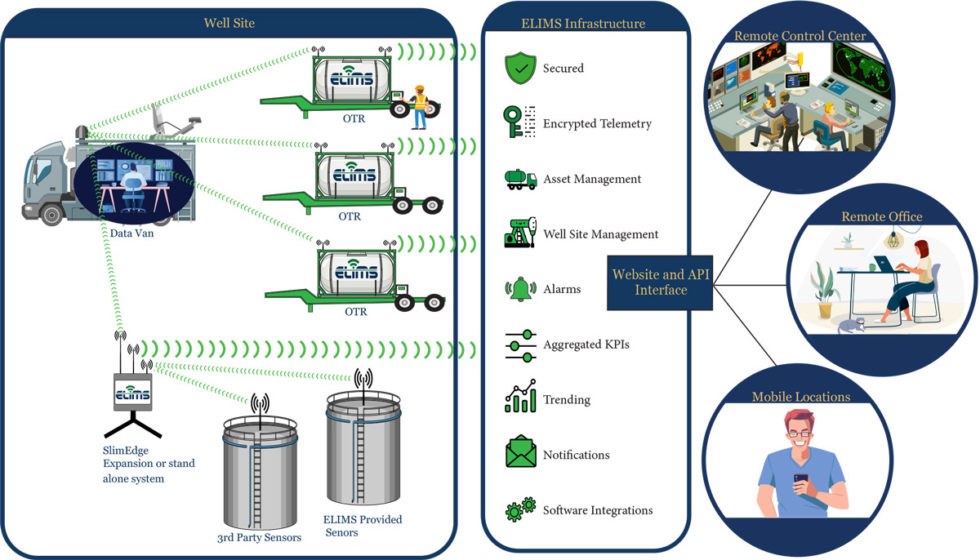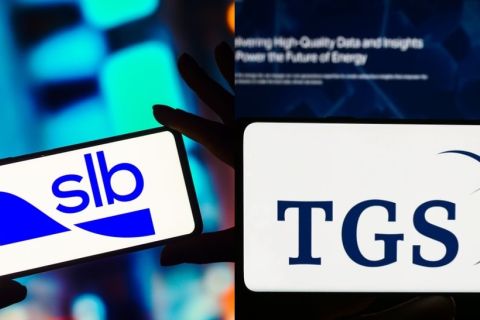
ELIMS, a division of Economy Polymers and Chemicals, developed a field-to-cloud chemical level monitoring system that was designed to improve the entire chemical supply chain. (Source: ELIMS)
Presented by:
Editor's note: This article originally appeared in the April issue of E&P Plus.
Subscribe to the digital publication here.
In today’s oil and gas industry, ESG efforts are top of mind, and it has become vital for the sustainability of operations. Optimizing the utilization of personnel and keeping them safe is paramount while their focus on higher value items also helps drive efficiency. In addition, support staff in remote locations are being spread across multiple site locations, increasing the number of variables they need to keep track of to ensure operations continue without nonproductive time (NPT). To achieve financial cost targets, more work needs to be done with fewer man hours, though safety and performance are priority. The advent of new specialized Internet of Things (IoT) applications is assisting with this transformation.
Chemical management on a frac site requires constant oversight. A modern frac site is limited in space, and the tanks that store chemicals are not large enough to store the entire volume necessary to complete the job, necessitating chemical replenishment to take place. This requires an understanding of current inventory, the rate of consumption and delivery lead time. All of these must be as accurate as possible to keep expense at a minimum. The process of checking the fluid level in the tanks is time-consuming and hazardous for field personnel. The communication between field personnel reporting inventory counts and the supply chain personnel managing replenishment orders is often inefficient. Task redundancy creates confusion, inaccuracies create waste and more man hours create cost and safety issues. All generating ESG concerns.
Gap in the market
The good news is there are currently a number of IoT-based fluid level monitoring devices available in the market that can help mitigate some of the efficiency losses and hazards. However, none of these devices where specifically built for this application and lack key features such as
- an onboard display for field personnel and delivery drivers, showing tank level, volume and temperature;
- a method to provide and visualize data in the field—this is critical because there is often limited cell or internet connectivity; and
- a turnkey complete network/system that securely delivers data at the field level, cloud level (API) and through a user interface with tailored dashboards and analytics.
Perhaps the largest deficiency of these level monitoring devices is the timing interval that they report data. Commonly, data from these devices are reported about one to three times per day depending on how often the end user wants to replace batteries. This timing interval is too infrequent to keep up with the fast-paced nature of modern oil and gas operations. Managing chemical replenishment with stale data typically leads to chemical depletion/NPT or driver demurrage due to not enough storage to fit a delivery.
Field-to-cloud chemical level monitoring
ELIMS, a division of Economy Polymers and Chemicals, developed a system to solve this problem. The system is a field-to-cloud chemical level monitoring tool that was designed to improve the entire chemical supply chain. The field component called Over the Road, or OTR, is engineered with field personnel in mind providing multiple methods to visualize data and eliminating the need to climb on top of tanks to obtain fluid levels, fill, drain or vent the tank. The cloud component, CloudViewer, was designed for staff supporting field operations, ordering chemicals and scheduling assets logistics.
Additionally, all data are available to the customer for use in proprietary or third-party analytics and visualization tools. All components are carefully designed with safety, reliability and security at the forefront. The system has been engineered to achieve low cost, flexibility and even expansion to monitor other sensors outside of mobile tankage.
Data management
The field component of the system typically mounts onto an ISO tank/trailer and continuously gathers data from a high-accuracy fluid level sensor and GPS antenna to determine meaningful information. Tank volume is computed from the level data on the order of seconds rather than minutes or hours typically seen. From these data, advanced algorithms capture frac stage consumption figures and tank refill events among other reports. Tank level, volume and temperature are sent to the cloud system every 15 minutes. Stage and refill information are sent to the cloud immediately after their completion is detected.

The GPS signal is used to report the position of the asset and determine if the system is in motion or stationary, allowing notifications to be sent indicating if the asset has arrived on site, is still en route, at a facility being reloaded or at a facility in standby status.
Tank level/volume visualization
Traditionally, field personnel complete a manual process called strapping, which determines the fluid level in the tank. This requires a person to climb on top of a 15-ft tank, open the man lid, stick an often warped or damaged wooden stick into the fluid, measure the fluid level on the stick, then correlate that measurement with an estimated strapping chart to determine the volume. This time-consuming process is often inaccurate, unsafe and must be completed frequently.
In addition, the chemical supply manager must actively keep track of the reported levels and make decisions on when to reorder.
OTR removes this process by continuously calculating the precise chemical volume. The system provides personnel multiple methods to view the tank information.
First, for field personnel, the onboard display shows chemical level, chemical volume, chemical temperature and system status data. Secondly, the system broadcasts a secured Wi-Fi signal that provides access to a local website where all tank parameters, deliveries, stages and other operational dashboards are provided. Since the visualization interface is a website, software does not need to be installed on computers or mobile devices used to connect to the system. The data that are visualized are updated every few seconds in near-real time.
Communications to the cloud
The method of sending secure data from the field to the cloud infrastructure has been a continually evolving component of the system. This aspect of the system is uniquely engineered to meet the challenges of the mobile nature of the application and the ruggedly remote locations where oil and gas is produced.
The first iteration of the cloud communications system included an IoT specific satellite terminal only. Since cellular devices and networks have grown tremendously, this has driven very competitive cellular data rates. Now cellular connectivity has been incorporated into the OTR system.
However, through exhaustive field testing and development, it was observed that cellular connectivity drops off in many field locations in Texas, depending on location and interestingly time of day. It also drops off in mountainous regions of Colorado, Wyoming and Montana. These are all areas where oil and gas activity are focused. To provide the highest datastream quality, redundancy is required. Cellular connectivity is the primary strategy, and the system automatically reverts to satellite for very reliable 24/7 data communication. Also, the company is currently testing various other options to increase reliability of the datastream.
Functionality
The CloudViewer is essentially the remote control center for the system. It’s typically utilized by consumers of the information that are not located in the field. The CloudViewer includes various modules, dashboards and controls to operate, audit and manage chemical inventory and logistics.
The data collected from the field is mapped into related business models so end users with different objectives can get the data they need quickly. The system also incorporates specific algorithms and analysis to help decrease the burdens of supply chain personnel so they can manage many job sites at a time.
The system utilizes text message and/or email to alert users of any number of parameters, including but not limited to chemical replenishment recommendations, high/low level alerts, temperature alerts, tank movement alerts, daily reports and refill completion reports.
Upon initial setup of the system, ELIMS representatives work with customers to configure these actionable alerts. The system is flexible and can also handle custom application requirements. Built on micro services, additional custom logic can be added quickly and reliably without effecting other modules of the system.
All deliveries and consumption stages/events are visualized. Customers even use the data provided by the highly accurate level sensor combined with the extensively developed algorithms to audit third-party data such as delivery amounts and stage consumption. In addition, chemical utilization is also totalized in terms of total delivered, total used and, for those using the invoicing module, total invoiced.
It is also possible to store associated documents in the system. These documents can be associated with the asset (OTR trailer) or well site. BOLs, JSAs and other documents are typically stored in these locations.
Recommended Reading
TGS, SLB to Conduct Engagement Phase 5 in GoM
2024-02-05 - TGS and SLB’s seventh program within the joint venture involves the acquisition of 157 Outer Continental Shelf blocks.
2023-2025 Subsea Tieback Round-Up
2024-02-06 - Here's a look at subsea tieback projects across the globe. The first in a two-part series, this report highlights some of the subsea tiebacks scheduled to be online by 2025.
StimStixx, Hunting Titan Partner on Well Perforation, Acidizing
2024-02-07 - The strategic partnership between StimStixx Technologies and Hunting Titan will increase well treatments and reduce costs, the companies said.
Tech Trends: QYSEA’s Artificially Intelligent Underwater Additions
2024-02-13 - Using their AI underwater image filtering algorithm, the QYSEA AI Diver Tracking allows the FIFISH ROV to identify a diver's movements and conducts real-time automatic analysis.
Subsea Tieback Round-Up, 2026 and Beyond
2024-02-13 - The second in a two-part series, this report on subsea tiebacks looks at some of the projects around the world scheduled to come online in 2026 or later.






